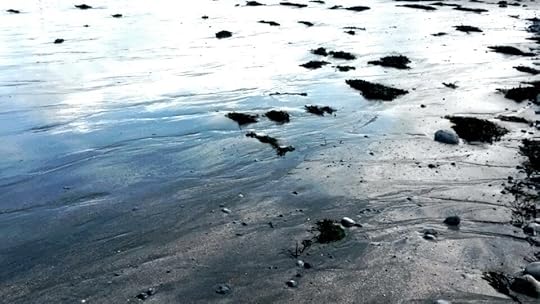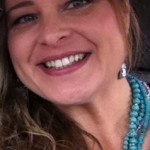Christine Valters Paintner's Blog, page 137
March 12, 2015
Monk in the World guest post: June Mears Driedger
I am delighted to share another beautiful submission for the Monk in the World guest post series from the community. Read on for June Mears Driedger's reflections about spiritual direction and the contemplative life:
Following the call of being a monk in the world through spiritual direction.
I enter the room for spiritual direction. My director, J. is there, lighting a candle and smiling as she greets me. I meet with her about every four-six weeks, depending on our schedules. This is a discipline I practice to deepen my relationship with God and enables me to be a monk in the world. With a spiritual director or companion I have someone who listens compassionately as I discern God’s presence and movement in my life. The loving presence of my spiritual companion enables me to slow down, pay attention, and listen.
I initially heard about spiritual direction from Lisa, an acquaintance more than two decades ago. She had a contemplative stillness that drew me to her and as we talked she mentioned “spiritual direction” then explained what it is in response to my quizzical facial expression.
“Spiritual direction is an ancient ministry which has gained a resurgence during the last 30 years. It is a relationship in which one person assists another in listening and discerning God’s presence in their lives,” she said. “The spiritual director serves as a companion on a life’s journey, listening attentively and contemplatively to an individual.”
A few hours later, while reflecting on our conversation, I heard in my heart the words, “You need to do this.” It was such an unusual experience to “hear” words from nowhere that I assumed this was from God. And I responded, “Yes, Lord.”
The next time I saw Lisa I asked her how I might find a spiritual director.
“I am delighted you’re interested!” she said. “Talk with Sr. Thomas at the diocese office. Here’s her phone number.” She retrieved a small address book from her purse, flipped through it and read the numbers to me.
I called Sr. Thomas and met with her in the diocese office. She was older, past retirement age, in nun’s habit. She carefully looked through several pages of names and occasionally paused, looked up, placed her forefinger tip on her chin, and said, “Maybe this person,” and jotted on a pad of paper near her on the desk. After about 15 minutes of this, she gave me three names with phone numbers of potential spiritual directors.
I met with each woman listed on the paper and after prayer and pondering, I began meeting with a Catholic laywoman with whom I met for nearly two years until I moved out of state.
Now I meet with J., a retired Episcopal priest, my seventh spiritual director in the 23 years since that conversation with Lisa and meeting with Sr. Thomas.
J. and I meet in her office located in a separate building behind her garage. We sit in chairs facing one another, near the windows looking out onto a meadow, and together we wait in silence, in prayer.
“I don’t know what to talk about today,” I say.
J. nods and waits.
“I’ve been working on some writing projects ….” My voice trails off.
She attentively waits.
“And I’m writing some stuff for my blog but I think I have offended some people.”
J. raises her eyebrows and asks, “Really?”
And in this moment I see that I have no idea if someone was offended. God reveals to me that I am very fearful of rejection and criticism—I am afraid of offending someone who will in turn reject me. And I see my fear as something God wants to heal and transform in me. I have slowed down enough to pay attention to the deeper movement of God in my life.
“I’m afraid and I feel very bound up by fear,” I say.
“Well, how do you pray about your fear?” she asks.
“I often pray, ‘Perfect love casts out all fear,’” I say. “But I don’t know if I believe this is true because I feel so afraid.”
“Do you want to talk to Jesus about your fear right now?” J. asks.
I nod yes and she leads me in a guided meditation where I offer my fear to Jesus but also ask him to help my unbelief. I use a lot of tissues during this prayer time.
We conclude the guided prayer and I feel some relief, some resolution, but I know managing my fear is a lifetime struggle for me.
J. says to me, “The opposite of fear is freedom that comes from faith. I suggest a breath prayer like, ‘Set me free Lord, set me free.’ I think if you focus on this prayer for the next several months you will begin to experience some inner freedom.”
It is her work as a spiritual director to help another feel welcomed and accepted “without judgment or distortion, subtraction or addition,” writes Richard Rohr in his book, Falling Upward. “Such perfect receiving is what transforms us. Being totally received as we truly are is what we wait and long for all of our lives.” A spiritual director sees us with God’s eyes and hears us with God’s ears and then enables us to see and hear ourselves as God does. In many ways, the spiritual director is a monk in the world (or, an actual monk!) who nurtures others into monkish ways in their own lives.
I agree with her and tell her I will begin using the prayer this very day. She doesn’t often suggest a specific prayer or assign “homework” but because I trust her—her wisdom, experience, and faith–I do as she suggests. We sit in a comfortable silence until I say, “Thank you—even though I didn’t have anything to talk about today, God certainly had a plan!”
We laugh together then she closes our time with prayer. My spiritual companion shares her time, presence, and wisdom and through our sessions together I have a greater awareness of God’s healing, transforming movement in my life. We set our next meeting, I pay her, hug her, and leave the room knowing that I have encountered God during this time of spiritual companionship. As I climb into my car I am able to continue the call of being a monk in the world.
 June Mears Driedger is a writer, editor, spiritual director, and retreat leader in Lansing, Michigan.
June Mears Driedger is a writer, editor, spiritual director, and retreat leader in Lansing, Michigan.
Click here to read all the guest posts in the Monk in the World series>>
March 10, 2015
Making Space for the Divine: The Gift of Silence
To receive this love note straight to your in-box, subscribe here (and also receive a free gift!)
For the next few weeks I will be offering you some gems from the Abbey archives as I create the space I need to finish several writing projects and prepare for spring's teaching:
It was said of Abba Agathon that for three years he lived with a stone in his mouth, until he had learnt to keep silence. (Agathon 15)
The silence of the desert elders is called hesychia, which means stillness, silence, inner quiet. However, it is much deeper than just an external quiet. A person can live alone and still experience much noise within and a person can live in the midst of a crowd and have a true sense of stillness in their heart.
There is always a shadow side to silence—the kind of silence that keeps hidden secrets and abuses. This is not the life-giving silence the desert elders seek. Silence can be poisonous, as when someone's voice is being silenced or when we silence ourselves out of resentment or anger. Think of times when you have engaged silence as a weapon in a relationship. There is also the silence of hopelessness or giving up, feeling overwhelmed by life. Or silence that comes when we feel another has all the answers and our voice doesn't matter.
The desert monks are talking about silence that is life-giving. They urge us to seek a particular quality of silence that is attentive and emerges from a place of calm and peace. Our freedom to be silent in this way indicates our freedom from resentment and its power over us. Authentic silence is very challenging to achieve.
Meister Eckhart wrote, "There is nothing so much like God as silence." When we experience moments when we find ourselves releasing words and simply entering into an experience of wonder and beholding, this is the silence of God, moments when we are arrested by life's beauty.
Silence is challenging. We create all kinds of distractions and noise in our lives so we can avoid it. Thomas Merton writes about people who go to church and lead good lives but struggle with quiet:
Interior solitude is impossible for them. They fear it. They do everything they can to escape it. What is worse, they try to draw everyone else into activities as senseless and as devouring as their own. They are great promoters of useless work. They love to organize meetings and banquets and conferences and lectures. They print circulars, write letters, talk for hours on the telephone in order that they may gather a hundred people together in a large room where they will all fill the air with smoke and make a great deal of noise and roar at one another and clap their hands and stagger home at last patting one another on the back with the assurance that they have all done great things to spread the Kingdom of God.
Merton is fierce in his critique of all the ways we cling to words to feel productive, while never making space to surrender into the unknowing of silence and experience silence as beyond all of our good words and intentions. Silence is what makes our actions meaningful, not the other way around.
The desert monks invite us to consider what it means to be selective about our words. Cultivating silence is about making space for another voice to speak. Silence is a presence rather than an absence. I can fill my day with endless words or I can choose when to speak and when to keep silent.
Abba Poemen said: "A (person) may seem to be silent, but if his heart is condemning others he is babbling ceaselessly. But there may be another who talks from morning till night and yet he is truly silent; that is, he says nothing that is not profitable." (Poemen 27)
Regular practice of silent prayer and meditation helps us to grow aware of the chatter of our minds and the judgments we carry about ourselves and others. By becoming fully present to these thoughts and being compassionate with ourselves, we can start to notice when they rise in everyday life. The desert elders remind us to pay attention to our inner judgments as a form of noise which poisons the silence we so desperately seek.
Sitting in your cell requires patience to not flee back into the world of distraction and numbness. It means being fully present to our inner life without anxiety. Interior peace comes through sitting in silence, through attentiveness and watchfulness.
Much of the time I find silence a deep source of consolation. However, there are many times when I find myself wrestling during my silent practice: watching the clock, feeling impatient, restless, distracted. The tempting thoughts arise that I could get up early and walk away, that I wasn't really present that day and so could try again tomorrow. And yet the call is precisely to stay with the practice when things become difficult. The desert elders said this was a lifelong struggle. They considered themselves beginners on the spiritual path. I try to remember this during my inner debate about staying put. I try to smile at myself. If these wise elders were beginners, then certainly I have only just begun to explore the possible depths of silence.
The desert elders warn us repeatedly about the ways we resist silence, especially in our interior chatter and the onslaught of thoughts most of us experience when we sit down to pray. In fact, this encounter in silence is often why we resist slowing down and being still. We fear what might be revealed in that space.
Our lives are precious. Each moment should be cherished. The more I stay with myself in those times of challenge, the more I open up the possibility of sustained and lasting peace. Lest we think this is a selfish activity, the world desperately needs this kind of peace that rises up from within the hearts of passionate and committed people. Silence awakens us to renewed vision, to a deepened awareness of the world around us.
We each live with fundamental lies, stories we tell about ourselves that are untrue. Our words help to strengthen the illusions we live with. Silence helps to free us from these constructions and heal us from our attachments. Our normal speech seems to reinforce the way we keep ourselves from freedom.
Silence isn't just the absence of sound, but a form of human consciousness. This silence of the heart is a profound place of moving beyond ego, judgments, and dualistic thinking to witness the presence of the divine. In silence, we can experience a sense of inner expansiveness which makes more room for God's presence.
With great and growing love,
Christine
Photo: Flaggy Shore (by Christine)
March 7, 2015
Invitation to Photography: Kinship with Creation – How might you nourish an Earth-cherishing consciousness?
 Welcome to this month's Abbey Photo Party!
Welcome to this month's Abbey Photo Party!
I select a theme and invite you to respond with images.
We began this month with a Community Lectio Divina practice with our reflection on Kinship with Creation (the fourth principle of the Monk Manifesto) with a quote from Psalm 104 (read them here).
I invite you for this month's Photo Party to hold these words in your heart as you go out in the world to receive images in response. As you walk be ready to see what is revealed to you as a visual expression of your prayer.
You can share images you already have which illuminate the theme, but I encourage you also to go for a walk with the theme in mind and see what you discover.
You are also welcome to post photos of any other art you create inspired by the theme. See what stirs your imagination!
How to participate:
You can post your photo either in the comment section below* (there is now an option to upload a file with your comment – your file size must be smaller than 1MB – you can re-size your image for free here – choose the "small size" option and a maximum width of 500).
You can also join our Holy Disorder of Dancing Monks Facebook group and post there. Feel free to share a few words about the process of receiving this image and how it speaks of the harvest for you.
*Note: If this is your first time posting, or includes a link, your comment will need to be moderated before it appears. This is to prevent spam and should be approved within 24 hours.
March 4, 2015
Monk in the World guest post: Carmen Brown
I am delighted to share another beautiful submission for the Monk in the World guest post series from the community. Read on for Carmen Brown's poetic wisdom on living as a monk in the world:
During a particularly difficult loss in my life, I discovered the path of the contemplative. This dark night of the soul caught me unexpected, unaware—grasping and gasping for relief and answers. Divinely, I met Christine Valters Paintner through her website and later her books. For the first time in my life, I felt home — a place where the expression of my soul found a voice, resonance, and peace. On a dreary winter day, Christine offered a call to return to Him with my whole heart . What happened next can only be explained as God-inspired. As I began to journal, a poem emerged, then an image. While I often journal my prayers, this was different. This was an encounter with the Holy Spirit in which He comforted, taught, and inspired me. Through my deepest aches and sufferings, a birth process began—one of surrender. I learned the truth of 1 Peter 5:10:
“And after you have suffered a little while, the God of all grace, who has called you to his eternal glory in Christ, will himself restore, confirm, strengthen, and establish you.”
The qualities that make us contemplatives are the same ones that intensify our sufferings, but also increase our joys.
May joy be given and shared with our whole hearts.
Border Shadows
Within my questions,
A revelation of lack,
Floods my soul with lamentations.
This root decay.
Lurking beneath the soil,
Like aphid eggs in winter’s hibernation.
Until the warmth of spring,
Brings back to life the death within the new growth.
Then and only then,
Does the truth appear.
Amid the green exists the brown,
The parasitic suck,
Chokes and destroys the intention,
And perseverance of life.
My God! Oh God!
Trust has become a border shadow,
Ever shifting and moving,
Dependent on surface, circumstance,
No roots of its own.
If I planted a sunflower,
And a daisy grew in its place,
Would I focus on the difference,
And deny its beauty?
Might I yank it out,
And curse its defiance and audacity?
Or would I trust the gift,
Although, not desired, expected?
Could I see its possibility?
Its promise?
Its purpose?
My soul’s cry,
Is that I would cup it tenderly,
Within my hands, and–
Behold its creation in solemn surrender to the Creator.
Carmen L. Brown is an assistant professor of English at a community college in Knoxville, TN. Additionally, she is a beholder of all things herbs. This passion led her to create Carmen’s Herbs, Balms and Salves, a small farmer’s market business of organically-crafted herbal skincare focused on the Creator and the awareness of self-nurturing practices. She can be reached at cbrown9673@aol.com.
Click here to read all the guest posts in the Monk in the World series>>
March 1, 2015
Sit in Your Cell: Desert Reflections for Lent (a love note from your online Abbess)
For the next few weeks I will be offering you some gems from the Abbey archives as I create the space I need to finish several writing projects and prepare for spring's teaching.
Dearest monks, artists, and pilgrims,
The road of cleansing goes through that desert. It shall be named the way of holiness.
—Isaiah 35:8
If the desert is holy, it is because it is a forgotten place that allows us to remember the sacred. Perhaps that is why every pilgrimage to the desert is a pilgrimage to the self. There is no place to hide and so we are found.
—Terry Tempest Williams, Refuge: An Unnatural History of Family and Place
In the fourth century, out in the desert landscape of Egypt, Syria, Palestine, and Arabia, a powerful movement was happening: the flowering of Christian monasticism in response to a call to leave behind the world. The center of this movement was in Egypt, and by the year 400 A.D. it was a land of hermits and monks experimenting with a variety of forms, including the solitary life of the hermit, the coenobitic or communal form of monasticism, and groups of ascetics.
The wisdom of this tradition forms the foundation for much of Christian spirituality that emerged in the following centuries, especially Benedictine and Celtic forms of monasticism. A literary genre emerged which was similar in form to parables and proverbs, story teachings to impart wisdom. These are gathered together in the Sayings of the Fathers (Apophthegmata Patrum), which include the wisdom of both the desert fathers and mothers.
The word for desert in Greek is eremos, which literally means "abandonment" and is the term from which we derive the word "hermit." The desert was a place of coming face to face with death. Nothing grows in the desert. Your very existence is, therefore, threatened. In the desert, you can only face up to yourself and to your temptations in life, which distract you from a wide-hearted focus on the sacred presence in the world. The desert is a place of deep encounter, not of superficial escape.
We do not have to journey to the literal desert to encounter its power. Each of us has desert experiences, seasons that strip away all of our comforts and assurances and leave us to face ourselves directly. Each of us can benefit from the wisdom of the desert mothers and fathers who speak to us across time.
St. Benedict, who was deeply influenced by the desert elders, wisely wrote 1500 years ago, "Always we begin again." As you move through your Lenten journey, you might want to write those words somewhere visible, to call you back each time your commitment to spiritual practice wavers. The desert is a place of new beginnings; it is where Jesus began his ministry. In the desert, we are confronted with ourselves, naked and without defenses, called again and again to bring back all of our broken and denied parts into wholeness.
The monastic cell is a central concept in the spirituality of the desert mothers and fathers. The outer cell is really a metaphor for the inner cell, a symbol of the deep soul work we are called to, to become fully awake. It is the place where we come into full presence with ourselves and all of our inner voices, emotions, and challenges and are called to not abandon ourselves in the process through distraction or numbing. It is also the place where we encounter God deep in our own hearts.
Abba Moses wrote, "A brother came to Scetis to visit Abba Moses and asked him for a word. The old man said to him: 'Go sit in your cell, and your cell will teach you everything.'"
Abba Anthony wrote a similar message: "Just as fish die if they stay too long out of water, so the monks who loiter outside their cell or pass their time with men of the world lose the intensity of inner peace. So like a fish going toward the sea, we must hurry to reach our cell, for fear that if we delay outside we shall lose our interior watchfulness."
Connected to the cell is the cultivation of patience. The Greek word is hupomone, which essentially means to stay with whatever is happening. This is similar to the central Benedictine concept of stability, which on one level calls monks to a lifetime commitment with a particular community. On a deeper level, the call is to not run away when things become challenging. Stability demands that we stay with difficult experiences and stay present to the discomfort they create in us.
In our cell, we are called to full presence to our inner life. We cultivate the inner witness and watch as our thoughts scurry between different states, notice our internal responses to things, and observe when our minds move to distraction as a way of avoiding engagement with life. The cell is the place where we grow in deep intimacy with our patterns and habits. When we become conscious of our methods of distraction, we can learn to bring ourselves always back to our experience.
For Lent, I invite you to cultivate presence to your own inner world. Allow yourself time for silence each day. In that space, let your breath carry you inward into your own monastic cell. Stay present with yourself as you notice emotions rising and falling.
Do you have an outer monastic cell—a room or space where you can pray without distraction?
How might you practice stability in your own life? What are the emotions that cause you to want to run in the other direction? Grief? Anger? Deep joy?
What are the ways you distract yourself from being fully present? We all have ways of numbing, whether through watching hours of television, surfing the internet, shopping, eating, drinking. Really, anything can serve as a way of numbing ourselves when we engage in them as a way of avoiding what we are experiencing within. Consider fasting from distraction this Lent and becoming more conscious of the ways you avoid staying with yourself.
If an outer pilgrimage calls to you, our dates for 2016 in Ireland have now been posted and you can find more information here.
With great and growing love,
Christine
Photo by Christine: John Paintner on the trail up to Maumeen Pass where St. Patrick is said to have journeyed. This is one of the journeys we make with pilgrims in our new pilgrimages itinerary out of Galway.
February 28, 2015
Invitation to Community Lectio Divina: Kinship with Creation – How might you nourish an Earth-cherishing consciousness?
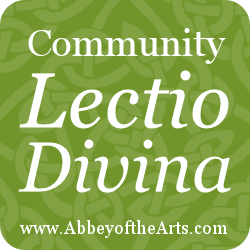 With March we offer a new invitation for contemplation. Our focus for this month is Kinship with Creation. We are continuing our monthly exploration of each theme of the Monk Manifesto. Our focus for this month is Kinship with Creation — How might you nourish an Earth-cherishing consciousness? The fourth principle reads:
With March we offer a new invitation for contemplation. Our focus for this month is Kinship with Creation. We are continuing our monthly exploration of each theme of the Monk Manifesto. Our focus for this month is Kinship with Creation — How might you nourish an Earth-cherishing consciousness? The fourth principle reads:
I commit to cultivating awareness of my kinship with creation and a healthy asceticism by discerning my use of energy and things, letting go of what does not help nature to flourish.
We invite you into a lectio divina practice with some words from Psalm 104 (see below).
How Community Lectio Divina works:
Each month there will be a passage selected from scripture, poetry, or other sacred texts (and occasionally visio and audio divina as well with art and music).
How amazing it would be to discern together the movements of the Spirit at work in the hearts of monks around the world.
I invite you to set aside some time this week to pray with the text below. Here is a handout with a brief overview (feel free to reproduce this handout and share with others as long as you leave in the attribution at the bottom – thank you!)
Lean into silence, pray the text, listen to what shimmers, allow the images and memories to unfold, tend to the invitation, and then sit in stillness.
You cause the grass to grow for the cattle,
and plants for people to use,
to bring forth food from the earth,
and wine to gladden the human heart,
oil to make the face shine
and bread to strengthen the human heart.
The trees of God are watered abundantly,
the cedars of Lebanon that God planted.
In them the birds build their nests;
the stork has its home in the fir trees.
The high mountains are for the wild goats;
the rocks are a refuge for the conveys.
You have made the moon to mark the seasons;
the sun knows its time for setting.
— Psalm 104:14-19
After you have prayed with the text (and feel free to pray with it more than once – St. Ignatius wrote about the deep value of repetition in prayer, especially when something feels particularly rich) spend some time journaling what insights arise for you.
How is this text calling to your dancing monk heart in this moment of your life?
What does this text have to offer to your discernment journey of listening moment by moment to the invitation from the Holy?
What wisdom emerged that may be just for you, but may also be for the wider community?
Sharing Your Responses
Please share the fruits of your lectio divina practice in the comments below (at the bottom of the page) or at our Holy Disorder of Dancing Monks Facebook group which you can join here. There are over 2900 members and it is a wonderful place to find connection and community with others on this path.
You might share the word or phrase that shimmered, the invitation that arose from your prayer, or artwork you created in response. There is something powerful about naming your experience in community and then seeing what threads are woven between all of our responses.
Join the Holy Disorder of Dancing Monks Facebook group here>>
*Note: If this is your first time posting, or includes a link, your comment will need to be moderated before it appears. This is to prevent spam and should be approved within 24 hours.
February 25, 2015
Monk in the World guest post: Dianne Jones
I am delighted to share another beautiful submission for the Monk in the World guest post series from the community. Read on for Dianne Jones' wisdom on living as a monk in the world:
Stop Breathe Believe – A Beginning to a New Way of Being
Several years ago I began PrairieFire, a three-year program of spiritual formation, to learn to walk alongside others in the process of slowing down and discovering the heart of their spirituality. My classmates and I often called ourselves the Monkettes. We learned together, we cried together, we dared greatly together, we shared deeply with one another, we listened to one another and we listened to God.
In the final year of the program I was in the beginning processes of giving birth to a book based on a practice I used as an individual and couple’s therapist. I had developed the practice when I was struggling with my own thinking – struggling with my own path, struggling with some major decisions regarding my career. I often give credit to the Monkettes as being the midwives, along with many others, of the book.
The practice of Stop Breathe Believe® is a practice that will help you first become aware of your thoughts, and then harness the power to allow in only the thoughts that help you on the journey to wholehearted living, while gently, without judgment, turning away the thoughts that impede you.
Stop Breathe Believe, like any new skill, takes practice, but you will get better at it, and the more adept you are at implementing it as a practice in your daily life, the more effective it is. With healthy patterns of thinking, you get healthy patterns of being.
Stop: At a predetermined cue (like a stoplight) orat a moment you find yourself struggling, stopwhat you’re doing and become aware of what you’re thinking. You may even want to say the words aloud, using your name: “Stop, Brenda;” or “Stop, Stephen.” Speak to yourself with kindness but firmness. Now, notice what’s going on in your mind. Whatever thought you find—and believe me, it could be anything!—simply become aware of it. Just recognize it, and note it without judgment. In keeping with the stoplight metaphor, if your thought is a green, life-affirming thought, take a moment to be grateful! If it’s a “red” or life-draining thought, move on to Breathe.
Breathe: As you’re able, change your physical position. Sit up straight so as to be able to make use of your lungs’ maximum capacity. Now, breathe in slowly through the nose for a count of four, and then at the top of the breath, exhale through the mouth for a count of eight. Deep, diaphragmatic breathing triggers the parasympathetic nervous system to relax the body—your heart rate slows, your respiratory rate slows, your muscles loosen. With each exhalation, you’ll feel your mind and your body begin to relax. Even if it’s for just a moment, you’re redirecting your attention away from the negative thought you noticed during Stop. You can rest and recharge in the Breathe portion of Stop Breathe Believe as long as you like.
Believe: When you feel ready, start to create a belief statement that truthfully addresses the thought you observed during Stop. Let’s say that the thought you became aware of was “I’m such an idiot for losing my temper.” An effective belief statement could be: “I’m so human.” Or: “I’m learning a new process that will help.” Or: “Anger does not define who I am.” Whatever your belief statement, it’s the stepping-stone to get you through the next obstacle. You can use your belief statement in the midst of a tense situation, or as an anchor throughout the day.
Through the process of Stop Breathe Believe you can stop the endless stream of thoughts and become awareof one thought that needs replacing, breathe your way to a state of calm openness, and then believe a unique truth statement of your own creation that brings release from the unhealthy thought that’s hindering you.
Stop Breathe Believe is a contemplative practice that can be essential during times of struggle and heartache. It can also help in the day to day events that cause us stress: an overburdened schedule, the difficult conversations we all face from time to time, the running late to an appointment, the miscalculation of the budget for the month. Each day offers an opportunity to practice beginning again – and reflecting in a calm way on how you want to relate to and respond to the world around you.
This blog post is adapted from STOP BREATHE BELIEVE: Mindful Living One Thought At A Time © Stop Breathe Believe, LLC.
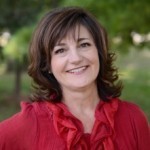 Dianne Morris Jones is a Licensed Mental Health Counselor (LMHC), a Certified Daring Way™ Facilitator – Consultant (CDWF-C), a Laughter Yoga Instructor, has training in Spiritual Direction and the Enneagram, and author of STOP BREATHE BELIEVE: Mindful Living One Thought At A Time. She practices at Family Legacy Counseling in Des Moines, Iowa.
Dianne Morris Jones is a Licensed Mental Health Counselor (LMHC), a Certified Daring Way™ Facilitator – Consultant (CDWF-C), a Laughter Yoga Instructor, has training in Spiritual Direction and the Enneagram, and author of STOP BREATHE BELIEVE: Mindful Living One Thought At A Time. She practices at Family Legacy Counseling in Des Moines, Iowa.
Click here to read all the guest posts in the Monk in the World series>>
February 21, 2015
Invitation to Dance: Community – Who is your tribe?
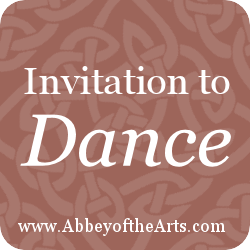 We continue our theme this month of "Community — Who is your tribe?" which arose from our Community Lectio Divina practice with the story from the Third Principle of the Monk Manifesto and continued with this month's Photo Party and Poetry Party.
We continue our theme this month of "Community — Who is your tribe?" which arose from our Community Lectio Divina practice with the story from the Third Principle of the Monk Manifesto and continued with this month's Photo Party and Poetry Party.
I invite you into a movement practice. Allow yourself just 5 minutes this day to pause and listen and savor what arises.
Begin with a full minute of slow and deep breathing. Let your breath bring your awareness down into your body. When thoughts come up, just let them go and return to your breath. Hold this question of "Who is my tribe?" as the gentlest of intentions, planting a seed as you prepare to step into the dance.
Play the piece of music below (Ravel's "Bolero" performed live, outdoors in Algemesí City, Spain) and let your body move in response, without needing to guide the movements. Listen to how your body wants to move through space in response to your breath. Remember that this is a prayer, an act of deep listening. Pause at any time and rest in stillness again. As more instruments are added to the song, see what arises in your own imagination about your community.
After the music has finished, sit for another minute in silence, connecting again to your breath. Just notice your energy and any images rising up.
Is there a word or image that could express what you encountered in this time? (You can share about your experience, or even just a single word in the comments section below or join our Holy Disorder of Dancing Monks Facebook group and post there.)
If you have time, spend another five minutes journaling in a free-writing form, just to give some space for what you are discovering.
To extend this practice, sit longer in the silence before and after and feel free to play the song through a second time. Often repetition brings a new depth.
February 18, 2015
Monk in the World guest post: Lance Baker
I am delighted to share another beautiful submission for the Monk in the World guest post series from the community. Read on for Lance Baker's reflections about cultivation as a metaphor for our spiritual life and practice:
A Life of Cultivation
A certain form of existential paralysis has shadowed my inner life in the past. I’ve had so many questions, dreams, longings, and have been exposed to a range of paradigm-shifting experiences in a relatively short period of time. As a result, I spent a number of years paralyzed by indecision and lacked discernment on how to operate the world with meaning, purpose, and authenticity. I felt like I could become anyone, go anywhere, engage in any of the numerous societal ills, learn any skill, etc. What I wasn’t spending much time reflecting on, however, was how God had already uniquely created me to be in the world. Of course I can always learn and grow, but in the past couple years I’ve been learning to ask questions like: Who am I already? How can I operate in a way that allows my own individuality to become a gift to myself and others rather than always thinking about who I want to become?
In Dennis, Shelia, and Matthew Linn’s book, “Healing the Purpose of Your Life” they talk about the importance of finding one’s “sealed orders.” Sealed orders are the special word(s) or phrase that perfectly sums up your distinct, God-infused, way of giving and receiving love—your unique way of being in the world. At this moment, the best way I've found to describe my life, my sealed orders, and what it means for me to be a monk in the world is to be a cultivator. Lance—the cultivator.
My wife and I lived on an organic farm for a few months after returning to the U.S. after two-years living in Vietnam. Something that became very apparent to me while working on the farm is that growing vegetables is entirely a work of cultivation. The term “grower” is somewhat amiss because the grower can only prepare the soil, plant the seeds, prune, thin, and tend to weeds. It is the somewhat mysterious work of the genetic material within the seeds, the sun, water, and creative work of God that do the actual growing. Being a monk in the world is all about maintaining this mode of cultivation for me.
I know that I cannot become more Christlike by my own efforts. I can only cultivate the soil, plant seeds, and tend to the weeds. This preparatory work and cultivation allows God to do the actual work and mysterious transformation in my heart.
A few years ago, I would have shied away from the prospect of leading small groups, writing a blog, or stepping forward as a spiritual director because I thought that I was responsible for the growth in myself and in others. I wouldn’t take that step forward because I never felt like I knew enough or that my skills weren’t polished enough. Now I am able to engage in those areas of ministry and helping relationships because I’ve come to see myself as a cultivator. The best that I can do is to cultivate growth in myself and in others by adding compost, pulling weeds, pruning, fertilizing, plowing, turning the soil, and sowing. What growth takes place after that is up to others and their own distinct relationship with God.
Crop rotation is an essential aspect to organic farming as well. If a particular crop gets planted in the same spot year after year it will eventually deplete the soil of the necessary nutrients and the crop quality may go down overtime. In my spiritual life, if I merely try the same approach over and over again, I tend to get bored, lack new growth, bear less fruit, and become more susceptible environmental threats (bugs and diseases are attracted to the weakest plants first). The variety of spiritual disciplines and and contemplative practices that have been part of the Christian tradition for centuries help me with my own “crop rotation” thus enabling me to remain fresh, attentive, and open to God’s grace in healthful ways.
Spiritual direction has been the biggest form of cultivation in my own life in the past two years. In addition to the value of that relationship is the natural introspection and examination that it invites. The week before my appointment with my director I will start more intensely thinking about what has been going on, what I want to talk about, what my primary questions or concerns are, and what my relationship with God has been like the past month. I need these structures of invitation to keep me accountable and to remind me of my intentions. In his book Orthodoxy, G.K. Chesterton writes, "If you leave a thing alone you leave it to a torrent of change. If you leave a white fence post alone it will soon be a black post. If you particularly want it to be white you must be always painting it again; that is, you must be always having a revolution.”
For me, constantly trying something new is key to avoiding falling into a state of decay—and it doesn’t always have to be a “spiritual" practice to cultivate that new. I’ve been learning to play clawhammer banjo for the last three years and I love how it has exposed me to the world of old-time folk music. I recently read Wendy Farley’s book, "The Wounding and Healing of Desire: Weaving Heaven and Earth” in which she draws heavily on the wisdom and truth of old folk songs and the way they so poignantly communicate the heart of human suffering and desire. Connecting the dots between my banjo playing, folk songs, desire, and suffering has been enlightening! I’ve also taken up scroll sawing as a hobby. Scroll sawing is a process of making very small and detailed cuts in thin pieces of wood to create intricate designs and patterns. There is something meditative about making these very slow and methodical cuts. It is an exercise in being present in the moment! It is also an interesting metaphor for the spiritual life. We might feel like plain old boards sometimes but there are a host of methodical, thoughtful, and attentive spiritual practices that (just like those scroll saw cuts) can turn plain old boards into unique, beautiful, authentic, and life-giving pieces of work that can become gifts to the world.
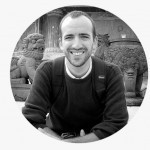 Lance Baker holds a Bachelors in Philosophy and Religion and recently completed his Masters in Spiritual Formation and Leadership through Spring Arbor University. He hopes to simply be another companion to those who are trying to ask deeper questions and see with increasing clarity. You can find more of his writings on his blog Quiet Pilgrim.
Lance Baker holds a Bachelors in Philosophy and Religion and recently completed his Masters in Spiritual Formation and Leadership through Spring Arbor University. He hopes to simply be another companion to those who are trying to ask deeper questions and see with increasing clarity. You can find more of his writings on his blog Quiet Pilgrim.
Soul's Slow Ripening and Sacred Seasons Registration
February 18-April 11, 2015* (8-week online retreat)
Description
"A new moon teaches gradualness and deliberation, and how one gives birth to oneself slowly. Patience with small details makes perfect a large work, like the universe. What nine months of attention does for an embryo forty early mornings alone will do for your gradually growing wholeness." — Rumi
The forty days of Lent offers us a beautiful opportunity to tend to your own gradually growing wholeness with keener attention and love.
Discernment is the process of listening for movements of grace and Spirit guiding us toward this wholeness, leading us closer to who we were created to be.
The Christian monastic tradition offers such a rich legacy of ancient wisdom for navigating our contemporary lives. The desert mothers and fathers of Egypt and Syria, Celtic monasticism as it flourished in Ireland and the British Isles, and Benedictine monasticism founded in Italy and later spreading through the continent of Europe.
Join us for this 8-week online retreat which takes us through the season of Lent and the first week of Easter. We will explore monastic riches for discernment and learning how to listen deeply to our lives for the call that is our own.
*We begin officially on Ash Wednesday, but we open the private retreat website on February 14th so you have a chance to settle in and get familiar with the format and with your fellow pilgrims
Weekly Themes (subject to modification & inspiration)
Week 0: Thresholds and liminal space
Week 1: Mindful attention and affectionate awareness
Week 2: Peregrinatio and following the thread
Week 3: You are a multitude
Week 4: Staying with what is uncomfortable
Week 5: Ripening and seasonal wisdom
Week 6: Yielding and organic unfolding
Week 7: Going to the wild edges
Weekly Content
Sunday: Introduction to week’s theme by Christine Valters Paintner
Monday: Invitation to Lectio Divina
Tuesday: Reflection on biblical texts by John Valters Paintner
Wednesday: Invitation to Photography
Thursday: Invitation to Writing
Friday: Integration of the week
Saturday: Holy Pause (no content / a chance for integration)
Forum Facilitators:
Amber Andreasen and Melissa Layer will be present in the online forum to respond to posts shared by the community and help hold the safety and sacrednesss of this virtual space. (See more about them on the Wisdom Council page)
Registration
*Please read through this entire section before making payment*
Combined registration discount: $250 –  – (register for this program and Sacred Seasons: A Yearlong Journey through the Celtic Wheel of the Year and save over half off the regular program fee, offer valid until February 18th).
– (register for this program and Sacred Seasons: A Yearlong Journey through the Celtic Wheel of the Year and save over half off the regular program fee, offer valid until February 18th).
If you have already registered previously for the Lent retreat and want to take advantage of the Combined registration discount with Sacred Seasons: A Yearlong Journey through the Celtic Wheel of the Year you can do that by using this payment button: $60 –  (please only use if you have already paid for the Lent retreat)
(please only use if you have already paid for the Lent retreat)
If the email address where you want to receive course notifications is different than the one you included for your payment (some folks use an alternate email for their Paypal account), please email the Abbey to update your registration with the correct contact information.
Please note there are no refunds for online classes, so consider your registration carefully. We have this strict policy in place to reduce the heavy burden of administration as we do not have enough support to handle this and thank you for your understanding and support for helping the Abbey to thrive. If you become ill and cannot participate, please know the materials stay available to you for several months, so you can always return to them at a later time. This is one of the gifts of the online format.
If you are not familiar with the Ruzuku online platform and format and have concerns about navigating the retreat website, please consider subscribing to our email newsletter which gives you access to our Monk in the World online class hosted on Ruzuku so you can test it out beforehand. Refunds are not given for technological challenges, but Ruzuku does have great support for participants. If you are able to navigate websites, receive email, and stream videos on YouTube you should have what you need.
2015: Imbolc (February 1st) to Winter Solstice (December 21st)
Description
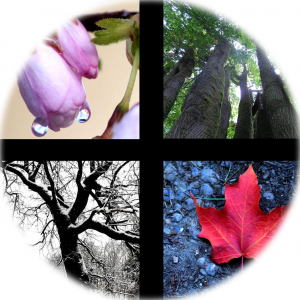 The Celtic Wheel of the Year is an ancient way of understanding the unfolding of the seasons and the slow turning of the earth. These eight hinges have ancient, pre-Christian roots, and link us to a cyclical rhythm, rather than a linear one.
The Celtic Wheel of the Year is an ancient way of understanding the unfolding of the seasons and the slow turning of the earth. These eight hinges have ancient, pre-Christian roots, and link us to a cyclical rhythm, rather than a linear one.
As the Christian Church developed, many of these festivals were supplanted by Christian liturgies, and reclaiming the connection helps us to deepen our understanding of the original inspiration for the sanctity of these times of year. We can begin to bridge the richness of possibility these potent times offer to us through a myriad of doorways.
A closer intimacy with the rhythms of creation offers us a wisdom about the patterns of rise and fall, fullness and emptiness in our lives. A great attentiveness to the liturgical rhythm connects us to an ancient way of praying through story and narrative.
The Celtic framework is an indigenous tradition for many of us and our ancestors. Even if we don't live in Ireland or the British isles, we may feel a kinship and connection to this understanding of the year's rhythms.
Join us for a vibrant yearlong offering. For each of the 8 festivals and hinges of the year you will receive an invitation to dive into the spirit of this season through a PDF file with a mini-retreat. It will offer you a guided experience through reflections on the season written by Christine Valters Paintner and biblical reflections by John Valters Paintner, invitations to contemplative practice and creative expression, poems, art, music, and dance. A wonderful way to spend a day of reflection as a holy pause and chance to tune into how your inner world is being called forth by the outer world.
We are also excited to include a series of new Taize-style meditative songs by Richard Bruxvoort Colligan for the feasts of Spring Equinox through Winter Solstice written for the Abbey, along with some accompanied by movement prayers from Betsey Beckman.
You can experience the first mini-retreat on Imbolc and the Feast of St. Brigid here for free.
Register below to receive all 8 and to join our secret Facebook group for sharing and conversation.
*With sincere apologies to my southern hemisphere friends, we will not be able to provide you with the seasons as you are experiencing them at this time. Once this cycle is complete for 2015 we will be able to offer this. In the meantime, you are still most welcome to join us and save the materials for your own unfolding cycles.
What is Included
At each of the 8 sacred hinges of the year you will receive an email with a link to a PDF with your mini-retreat. As described above, the mini-retreat will contain reflections and opportunities for practice and integration.
There will also be the option of a secret Facebook group dedicated only for those who have registered for this program. It will be a place where you can share your reflections, insights, and questions about the seasonal material and what you are discovering about the sacred rhythms of your own life. Guidelines will be posted to maintain a safe and sacred environment and will be gently facilitated by Liz Rasmussen, one of our wonderful helper monks.
Overview
February 1: Imbolc, Feast of St. Brigid, Presentation, and Candlemas* (free gift)
March 20: Spring Equinox and the Coming of Easter
May 1: Beltaine and Pentecost
June 21: Summer Solstice and the Feast of St. John the Baptist (June 24th)
August 1: Lughnasa, Transfiguration, Assumption, and Pilgrimage season in Ireland
September 20: Autumn Equinox and Feast of St. Michael
November 1: Samhain, Feasts of All Saints and All Souls
December 21: Winter Solstice and the Feast of Christmas (December 25th)
*You have the opportunity to preview the first mini-retreat for free! If you want to join the yearlong program and the secret Facebook group for sharing and conversation, please complete your registration below. Early registration brings a discount. Combined registration with our Lent retreat brings an even bigger discount.
Registration
*Please read through this entire section before making payment*
When you register for this program, you will receive an automatic email confirmation with a link to a private password-protected page with access to the materials as they become available. If you do not receive this email please check your spam folder and then contact us if still missing.
The email will provide you with a link to a private page where you can subscribe to receive the email notifications for when the materials for each festival are ready. The PDFs will all be posted here as well in case you lose one of your emails, as well as instructions for joining our secret Facebook group.
Regular program fee: $120
Early registration discount: $100 –  – special offer valid until February 18th
– special offer valid until February 18th
Combined registration discount: $250 –  – (register for this program and our online retreat for Lent – The Soul's Slow Ripening: Monastic Wisdom for Discernment and save half off the regular program fee, offer valid until February 18th). If you are already registered for Lent, go to the Lent page to "add on" the Sacred Seasons program.
– (register for this program and our online retreat for Lent – The Soul's Slow Ripening: Monastic Wisdom for Discernment and save half off the regular program fee, offer valid until February 18th). If you are already registered for Lent, go to the Lent page to "add on" the Sacred Seasons program.
If the email address where you want to receive course notifications is different than the one you included for your payment (some folks use an alternate email for their Paypal account), please email the Abbey to update your registration with the correct contact information.
Please note there are no refunds for online classes, so consider your registration carefully. We have this strict policy in place to reduce the heavy burden of administration as we do not have enough support to handle this and thank you for your understanding and support for helping the Abbey to thrive. If you become ill and cannot participate, please know the materials stay available to you for several months, so you can always return to them at a later time. This is one of the gifts of the online format.
Would you like to make an additional donation to the Earth Monastery Project and our Scholarship Fund (to support those who cannot otherwise afford to participate in programs)?

Discounts are available for small groups wanting to move through the material together: 20% off when 3 people register together, 30% off for 5, 40% off for 10, 50% off for groups of 20 or more. Please email the Abbey to request an invoice (payment must be made through one person).
A limited number of partial scholarships are available. Please email the Abbey and indicate the retreat you are interested, the specific amount of financial assistance you are requesting, and why this retreat calls to you at this time in your life.
Guides for both Journeys
 Christine Valters Paintner, PhD, REACE is the online Abbess of www.AbbeyoftheArts.com, a virtual monastery offering resources, retreats, and pilgrimages which integrate contemplative practice and creative expression. She is the author of 8 books on monasticism and creativity including her forthcoming The Soul of a Pilgrim: Eight Practices for the Journey Within. She lives in Galway, Ireland with her husband John.
Christine Valters Paintner, PhD, REACE is the online Abbess of www.AbbeyoftheArts.com, a virtual monastery offering resources, retreats, and pilgrimages which integrate contemplative practice and creative expression. She is the author of 8 books on monasticism and creativity including her forthcoming The Soul of a Pilgrim: Eight Practices for the Journey Within. She lives in Galway, Ireland with her husband John.
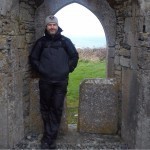 John Valters Paintner, MTS studied education and earned a teaching certificate in his home state of California. John later went on to earn a Masters in Theological Studies at the Jesuit School of Theology in Berkeley. After working in parish ministry for several years, John returned to the classroom, teaching high school religion for twelve years. He now works as Prior of the Abbey of the Arts alongside his wife of twenty years, Abbess Christine.
John Valters Paintner, MTS studied education and earned a teaching certificate in his home state of California. John later went on to earn a Masters in Theological Studies at the Jesuit School of Theology in Berkeley. After working in parish ministry for several years, John returned to the classroom, teaching high school religion for twelve years. He now works as Prior of the Abbey of the Arts alongside his wife of twenty years, Abbess Christine.

